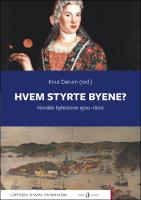Hvem styrte byene?
Nordisk byhistorie 1500–1800
| dc.contributor.editor | Dørum, knut | |
| dc.date.accessioned | 2022-06-07T07:37:44Z | |
| dc.date.available | 2022-06-07T07:37:44Z | |
| dc.date.issued | 2022 | |
| dc.identifier | OCN: 1367235169 | |
| dc.identifier.uri | https://library.oapen.org/handle/20.500.12657/56659 | |
| dc.description.abstract | This book, written by 12 authors, asks: Who governed the Nordic towns from c. 1500 to 1800? The book is inspired by pivotal studies undertaken by Finn-Einar Eliassen in the late 1990s concerning the progression of family dynasties in ruling several small towns in Norway from c. 1600–1800. Eliassen ascertained that 8–10 small Norwegian towns happened to be dominated by two-three families in economic, social, political and administrative matters. He maintained that ownership of the very ground upon which the town was built came to define a privatized lordship, not only in Norway but also in various peripheries in central and northern Europe. Our investigations explore quite opposite patterns. The Norwegian landlords more effectively dominated their towns – compared with landlords in Danish, Finnish, and Baltic towns – by actually living and working there, and due to their vast engagement in lumber trade and shipping. In other parts of the Nordic region the landlords normally did not reside in the towns or get involved in business in the town district. However, they possessed other types of power and authority. Finally, we assert that the paths to power and wealth in privatized monopoly towns lay in the establishment of social networks, the ownership of strategic land estates in connection with trade, industry and transport, and, above all, controlling the credit system that bound the peasants and other social groups to supply their masters with labour, lumber, agricultural products, and so on. However, the power of the dynasties had obvious limitations. | en_US |
| dc.language | English | en_US |
| dc.language | Norwegian | en_US |
| dc.subject.other | political economy, small town feudalism, privatized monopoly towns, family dynasties, company towns, network towns, politisk økonomi, småbyføydalisme, privatiserte monopolbyer, familiedynastier, nettverksbyer | en_US |
| dc.title | Hvem styrte byene? | en_US |
| dc.title.alternative | Nordisk byhistorie 1500–1800 | en_US |
| dc.type | book | |
| oapen.abstract.otherlanguage | Denne boka kretser rundt spørsmålet om hvem som styrte de nordiske byene ca. 1500–1800. Boka – skrevet av tolv forfattere – er inspirert av Finn-Einar Eliassens pionerarbeid fra 1990-årene om familiedynastier i norske byer. Eliassen kom fram til at åtte–ti norske småbyer i perioden 1600–1800 ble dominert av to–tre familier økonomisk, sosialt, politisk, administrativt og kulturelt, noe han mener også har vært mønstre i periferier i Nord- og Sentral-Europa. Kilden til makt lå i det å eie bygrunnen. Våre undersøkelser viser andre mønstre. De norske godseierbyene ca. 1500–1800 skilte seg ut fra tilsvarende byer i resten av Norden på flere måter. I Norge kom byherrene til å styre og dominere mer, de var sterkt involvert i næringsvirksomheten, og de bodde i byene. I resten av Norden ble godseierbyene preget av andre økonomiske eliter og av at godseierne ikke residerte i byene. På den andre siden hadde danske, svenske og finske godseiere andre maktmuligheter enn de norske. Samtidig avdekker våre funn at det å eie grunnen ofte ikke var hovedkilden til makt og rikdom i en by. Dynastier og eliter fant ressursene i sosiale nettverk og strategisk eierskap i næringer og kredittsystemer. Like viktig var det at byherrenes makt i Norden på flere måter var begrenset. | en_US |
| oapen.identifier.doi | 10.23865/noasp.149 | en_US |
| oapen.relation.isPublishedBy | bf7b42a4-6892-42e3-aaf8-8f32c8470a8b | en_US |
| oapen.relation.isbn | 9788202746308 | en_US |
| oapen.relation.isbn | 9788202759773 | en_US |
| oapen.relation.isbn | 9788202759780 | en_US |
| oapen.relation.isbn | 9788202759797 | en_US |
| oapen.pages | 363 | en_US |
| oapen.place.publication | Oslo | en_US |

